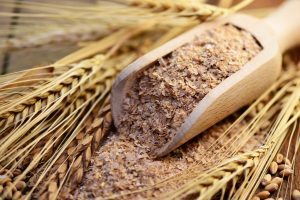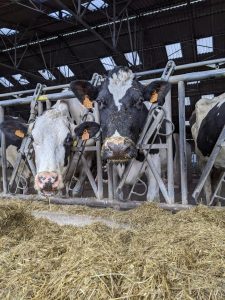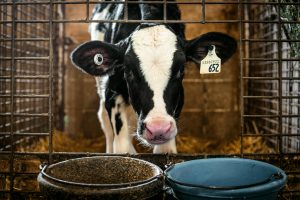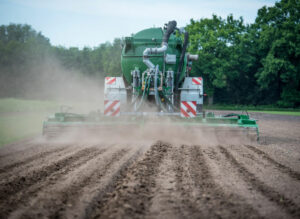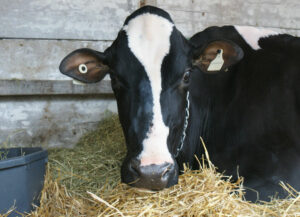Álvaro García
Forage shortages and low milk prices consistently challenge dairy producers by squeezing profitability and disrupting herd productivity. In this article we provide practical, evidence-based strategies to help dairy operations remain economically viable and productive during these difficult periods. By optimizing stocking density, strategically choosing alternative feed resources, enhancing milk quality, prioritizing cow health, and leveraging modern technologies, dairy producers can effectively manage costs and maximize productivity. The management practices discussed here are supported by clear economic benefits, offering producers tangible solutions to improve farm resilience and profitability, even amid challenging market conditions.
Optimize space use
Recent analyses suggest that increasing milk production by just 3 pounds (1.5 L) per cow per day on a 100-cow dairy can increase net income significantly. For instance, an additional 3 pounds per cow daily equates to approximately $7,500 annually (assuming a milk price of $18 per cwt). Before adding more cows to the herd, optimize the productivity of the existing cows. Ensure that all stalls are occupied by cows that maximize production efficiency. Slight overcrowding can sometimes benefit total milk production if managed properly without compromising cow comfort, provided feed and resting spaces are sufficient. For instance, in a facility designed for 1000 cows, slight overcrowding would be housing 1050 to 1100 cows. This level of overcrowding, when carefully managed, can benefit overall farm productivity by spreading fixed costs over more animals and increasing total milk output per facility.
However, the success of slight overcrowding relies heavily on meticulous management practices. To maintain productivity and animal well-being under these conditions, it’s important to ensure all cows have adequate and continuous access to clean water, sufficient bunk space for simultaneous feeding (ideally 24–30 inches or 61-76 cm of linear feed bunk space per cow), and ample resting opportunities. Additionally, effective ventilation, temperature control, frequent bedding replacement, and proactive herd-health management programs are essential to prevent stress-related health issues. When these management practices are properly implemented, slight overcrowding can boost profitability without negatively impacting comfort or health, creating a scenario where productivity and economic efficiency are simultaneously enhanced.
Choose feedstuffs carefully
Regularly monitor forage quality and match forage types and qualities to the cows’ lactation stages. High-producing early lactation cows require nutrient-dense diets and should receive your highest-quality forage. Lower-producing groups or dry cows can utilize lower-quality forages effectively. Forage shortages and grain price volatility make alternative forages and byproducts increasingly attractive. Recent research confirms that using digestible fiber sources—such as distillers’ grains, soybean hulls, beet pulp, and wheat middling’s—can help maintain or even enhance milk production while reducing dependency on expensive conventional forages and grains.
Distillers’ grains (DDGS), a byproduct of the ethanol industry, remain popular due to their nutrient density, providing protein, energy, and fiber without adversely affecting rumen pH. A study by Weiss (2019) indicated that including DDGS at moderate levels (15-20% of the ration DM) maintained milk production and improved milk composition by increasing unsaturated fatty acids.
Soy hulls and beet pulp also serve as valuable sources of energy because of their fermentable fiber. Their moderate protein content and high digestibility complement lower-quality forages. Recent studies confirm their utility in maintaining rumen health and improving milk component yields during forage shortages.
Improving milk quality can boost returns
Milk quality improvement remains one of the simplest ways to increase dairy profitability, even under low milk price scenarios. Lowering somatic cell counts (SCC) from 400,000 cells/ml to under 200,000 cells/ml not only improves milk quality payments but also boosts milk yield and animal health. Current research suggests that lowering SCC to 200,000 cells/ml can add approximately $0.20 per cwt to the milk price and boost milk yield by about 2 lb. (0.9 L) per cow daily.
Similarly, reducing bacterial counts below 25,000 colony-forming units/ml can further increase milk payments and extend shelf-life, positively influencing consumer perception and marketability. Improving overall milk quality through focused management and sanitation practices is an essential profitability strategy.
Proper milking routines are critical to achieving consistently high milk quality. Effective pre-milking procedures, such as teat cleaning, drying, and stimulation, enhance milk let-down and help prevent bacterial contamination. Adopting post-milking practices, including teat dipping with effective disinfectants, significantly reduces mastitis-causing pathogens.
In addition, establishing and rigorously following mastitis treatment protocols can dramatically decrease the incidence and severity of infections. Prompt detection and appropriate treatment of clinical mastitis cases, as well as strategic use of dry cow therapy, can significantly reduce somatic cell counts and improve overall health. Regular employee training and monitoring of milking procedures also ensure adherence to best practices, enhancing milk quality and profitability.
Prioritize cow health and longevity
Reducing costs in ways that negatively impact cow health or comfort—such as skimping on bedding, high-quality feeds, or veterinary care—is counterproductive. Instead, reduce expenses by postponing non-essential capital purchases like equipment upgrades, facility improvements, or non-critical investments until the financial outlook improves.
Evaluate herd replacement strategies carefully. High replacement rates might indicate underlying issues with cow comfort, health, or management rather than merely a need for more heifers. Improving cow longevity through enhanced management, health monitoring, and nutritional strategies can significantly reduce replacement costs. Recent estimates suggest that the cost to raise or purchase a dairy replacement heifer typically ranges from $1,500 to $2,500. Extending cow longevity by even a single lactation across the herd can substantially lower annual replacement costs. For example, reducing the herd replacement rate by 5% in a 100-cow dairy could translate into savings of $7,500 to $12,500 annually. These savings clearly illustrate the economic benefit of prioritizing cow health, comfort, and overall herd management to improve cow longevity.
Modern technologies play an increasingly important role in cost-effective herd management, especially for larger operations or during times of economic pressure. For example, using 3D camera technology provides a non-invasive method to accurately monitor cow body weight, assess body condition scores, and detect early signs of lameness. These systems enable proactive herd management by identifying cows needing nutritional or veterinary interventions before serious health problems occur. By integrating such advanced monitoring technologies, dairy producers can maintain optimal cow health and productivity, thereby reducing costs associated with illness, veterinary care, premature culling, and unnecessary replacements.
The economic benefits of adopting these proactive health management technologies can be substantial. Early lameness detection alone can save approximately $50 per cow annually, while improving reproductive efficiency may increase production value by about $100 per cow per year. Additionally, ketosis prevention strategies can yield around $30 in annual savings per cow, and optimizing feed efficiency can further save approximately $50 per cow each year. Taken together, these practices can result in total potential savings of around $230 per cow annually. Given a modest rental cost of about $1 per cow per month, the return on investment (ROI) from employing these modern monitoring technologies ranges from 200% to 500%, underscoring their substantial value to dairy operations. Ultimately, leveraging technology not only enhances cow welfare but also significantly improves the dairy operation’s long-term economic efficiency.
Effectively overcoming forage shortages and periods of low milk prices requires a strategic, comprehensive approach emphasizing efficiency, animal welfare, and innovation. Dairy producers who proactively manage cow comfort, carefully optimize stocking density, strategically utilize alternative feed resources, and maintain rigorous milk-quality protocols will achieve sustained productivity even during challenging economic conditions. By integrating cutting-edge technologies, such as 3D monitoring systems and precision feeding techniques, producers can enhance cow health and longevity while significantly improving operational profitability. Of all the strategies suggested, improving milk quality through enhanced milking routines and mastitis prevention is typically the easiest to implement and provides the quickest positive financial impact. These measures—such as effective pre- and post-milking procedures, teat dipping, and prompt mastitis treatment—require minimal additional investment and yield immediate benefits through reduced somatic cell counts and bacterial contamination. Improved milk quality rapidly translates into higher milk payments and increased production, offering a direct and timely boost to profitability.
References:
Weiss, W.P. (2019). Evaluating alternative fiber sources in dairy cow diets. Journal of Dairy Science, 102(5), 3776-3786.
St-Pierre, N.R., & Knapp, J.R. (2021). Economic impact of improving milk quality through somatic cell count reduction. Journal of Dairy Science, 104(2), 1945-1955.
Heinrichs, A.J., & Kononoff, P.J. (2021). Management strategies during feed shortages for dairy cows. Dairy Nutrition and Management, Penn State Extension.
© 2025 Dellait Knowledge Center. All Rights Reserved.



